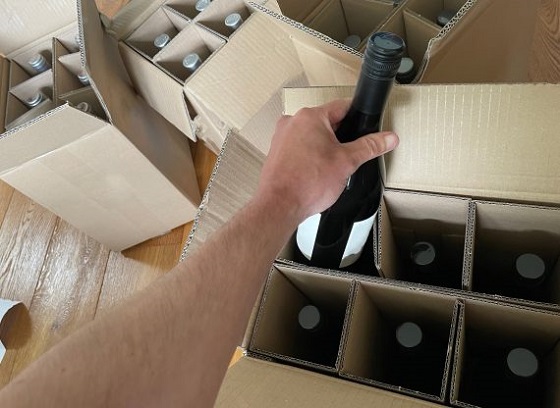Business
Provincial governments should follow Manitoba’s lead and allow the online sale of alcoholic beverages from other provinces

From the Montreal Economic Institute
By Shal Marriott and Gabriel Giguère
Removing Interprovincial Barriers to Online Alcohol Sales
Canada’s provincial and territorial governments should allow consumers to shop online for alcoholic beverages produced elsewhere in the country, indicates an MEI publication.
“The restrictions imposed by provincial alcohol monopolies are such that it is sometimes easier for a Canadian producer to sell its products on the other side of the world than in the province next door,” explains Shal Marriott, research associate at the MEI and author of the study. “By allowing producers to sell their products online, directly to consumers, our provincial governments would remove obstacles to their growth.”
In 2019, the federal, provincial, and territorial governments had committed to improving interprovincial trade in alcoholic beverages. This commitment stems directly from the Canadian Free Trade Agreement, signed two years before.
Manitoba is the only province to allow its residents to shop online for Canadian alcoholic beverages from other provinces, without restriction.
British Columbia, Saskatchewan, Alberta, and Nova Scotia have partial restrictions, allowing consumers to shop online for certain categories of products from specific parts of the country.
Ontario, Quebec, New Brunswick, Prince Edward Island, and Newfoundland and Labrador each continue to prohibit consumers from shopping online for alcoholic beverages from outside the province.
“By opening the door to this online commerce, our provincial governments would allow consumers to discover new products that they otherwise cannot purchase at home,” says Ms. Marriott. “This is the kind of simple measure that could also give our microbreweries, our wineries, and our distilleries a helping hand.”
The alcoholic beverage sector contributes over $4.4 billion to the Canadian economy, according to the latest available data.
Viewpoint calling on Canada’s provincial governments to allow the unrestricted online purchase and shipment of alcoholic beverages from one province to another
* * *
This Viewpoint was prepared by Shal Marriott, Research Associate at the MEI, in collaboration with Gabriel Giguère, Senior Policy Analyst at the MEI. The MEI’s Regulation Series aims to examine the often unintended consequences for individuals and businesses of various laws and rules, in contrast with their stated goals.
In October 2012, retiree Gerard Comeau was stopped by the RCMP and fined for bringing a too large quantity of beer and liquor from Quebec into New Brunswick, violating the personal exemption limit in place. In its ruling on the Comeau case in April 2018, the Supreme Court of Canada upheld provincial governments’ right to maintain such restrictions, provided they did not intentionally impede interprovincial alcohol trade.(1)
A year later, however, the federal government and the provinces agreed on an Action Plan “to enhance interprovincial trade of alcoholic beverages,” stemming from the 2017 Canadian Free Trade Agreement (CFTA).(2) This included increasing, and ultimately eliminating, personal use exemption limits (which set the amount of alcohol one can bring back from another province) and creating e-commerce platforms.(3)
Some progress has been made to raise or remove personal exemption limits across the country, meaning that Canadians can now import and transport alcohol more easily across most provincial lines for personal consumption, without penalty.(4) Most provinces, however, have failed to liberalize other areas of interprovincial alcohol trade, such as interprovincial online retail sales of alcoholic products, thus depriving Canadians of the benefits of greater competition, namely a broader choice of products and lower prices.
The Current State of Online Alcohol Retail Sales
There have been some efforts to allow greater freedom in online alcohol sales, such as Saskatchewan and British Columbia allowing a limited form of direct-to-consumer sales and shipping of wine and craft spirits from producers in the other province.(5) However, most Canadian provinces continue to prohibit the online retail sale of alcoholic beverages from other provinces directly to their consumers. For example, the Société des alcools du Québec (SAQ) states that while producers are not restricted formally from offering to sell to residents of Quebec, it is illegal for those Quebec residents to make such purchases and have them shipped into the province.(6)
As can be seen in Table 1, few provinces allow producers from other provinces to ship directly to consumers. Manitoba is the only Canadian province with no interprovincial online purchasing restrictions. The restrictions that have been removed in Western provinces and Nova Scotia are also relatively limited (and mainly concern wine). Quebec and Ontario retain complete prohibitions, which is hardly surprising as they are also among the provinces that have made the least progress towards the liberalization of internal trade more broadly.(7)

While we see some improvement in Alberta’s willingness to allow some direct-to-consumer shipments, continued protectionism still exists in the province’s alcohol trade. For example, in January 2024, the Alberta Gaming, Liquor and Cannabis (AGLC) corporation argued that direct-to-consumer shipping was having a negative impact on the provincial liquor monopoly.(8) In reaction, it threatened to stop selling BC wines in its stores until this practice ceased, and this position was seemingly supported by the Alberta government as there was no action to condemn the stance of the AGLC.(9)
Although a memorandum of understanding was reached six months later, ending a temporary ban that had been imposed, this showcases that provincial liquor monopolies, and provincial governments, are willing to enforce interprovincial trade barriers that ultimately deprive Canadian producers and consumers.(10)
The Benefits of Direct-to-Consumer Purchasing Online
There has been a general growth in the online consumer goods market, but Canadian producers and consumers of alcohol products have been unable to fully participate in, and benefit from, this opportunity. This protects provincial alcohol monopolies with their brick-and-mortar stores, which are thus shielded from online competition, at the expense of consumers and producers, whose ability to engage in trade with each other is limited.(11)
Liquor monopolies thus find it easier to impose artificially high prices on the products they retail. The SAQ, for instance, imposes markups on bottles of wine which, when combined with excise and sales taxes, can account for over 75% of the retail price of the product.(12)
Abolishing these restrictions on interprovincial shipping directly to consumers would allow Canadians in any province to freely order online from alcohol producers anywhere in the country. Online sales are one of the most convenient ways for consumers to purchase alcohol from other provinces. Opening up this type of commerce would also be good for smaller breweries, wineries, and distilleries, allowing them to expand their reach within the domestic market.
The federal government has declared a commitment to an increasingly liberalized domestic alcohol market.(13) Yet, this liberalization is being hindered by provincial governments and alcohol monopolies that limit the growth of the domestic market. For the sake of Canadian consumers and producers alike, the provinces should simply allow the unrestricted online purchase and shipment of alcohol from other provinces.
Business
Major tax changes in 2026: Report

The Canadian Taxpayers Federation released its annual New Year’s Tax Changes report today to highlight the major tax changes in 2026.
“There’s some good news and bad news for taxpayers in 2026,” said Franco Terrazzano, CTF Federal Director. “The federal government cut income taxes, but it’s hiking payroll taxes. The government cancelled the consumer carbon tax, but it’s hammering Canadian businesses with a higher industrial carbon tax.”
Payroll taxes: The federal government is raising the maximum mandatory Canada Pension Plan and Employment Insurance contributions in 2026. These payroll tax increases will cost a worker up to an additional $262 next year.
For workers making $85,000 or more, federal payroll taxes (CPP and EI tax) will cost $5,770 in 2026. Their employers will also be forced to pay $6,219.
Income tax: The federal government cut the lowest income tax rate from 15 to 14 per cent. This will save the average taxpayer $190 in 2026, according to the Parliamentary Budget Officer.
Carbon taxes: The government cancelled its consumer carbon tax effective April 1, 2025. However, the government still charges carbon taxes through its industrial carbon tax and a hidden carbon tax embedded in fuel regulations.
The industrial carbon tax will increase to $110 per tonne in 2026. While the government hasn’t provided further details on how much the industrial carbon tax will cost Canadians, 70 per cent of Canadians believe businesses pass on most or some of the cost of the tax to consumers, according to a Leger poll.
Alcohol taxes: Federal alcohol taxes are expected to increase by two per cent on April 1, 2026. This alcohol tax hike will cost taxpayers about $41 million in 2026-27, according to industry estimates.
First passed in the 2017 federal budget, the alcohol escalator tax automatically increases excise taxes on beer, wine and spirits every year without a vote in Parliament. Since being imposed, the alcohol escalator tax has cost taxpayers about $1.6 billion, according to industry estimates.
“Canadians pay too much tax because the government wastes too much money,” Terrazzano said. “Canadians are overtaxed and need serious tax cuts to help make life more affordable and our economy more competitive.
“Prime Minister Mark Carney needs to significantly cut spending, provide major tax relief and scrap all carbon taxes.”
You can read the CTF’s New Year’s Tax Changes report here.
Business
Inflation Reduction Act, Green New Deal Causing America’s Energy Crisis


From the Daily Caller News Foundation
By Greg Blackie
Our country is facing an energy crisis. No, not because of new demand from data centers or AI. Instead, it’s because utilities in nearly every state, due to government imposed “renewable” mandates, self-imposed mandates, and the supercharging of the Green New Scam under the so-called “Inflation Reduction Act,” have been shutting down vital coal resources and building out almost exclusively intermittent and costly resources like solar, wind, and battery storage.
President Donald Trump understands this, and that is why on day one of his administration he declared an Energy Emergency. Then, a few months later, the President signed a trio of Executive Orders designed to keep our “beautiful, clean coal” burning and providing the reliable, baseload, and affordable electricity Americans have benefitted from for generations.
Those orders have been used to keep coal generation online that was slated to shut down in Michigan and will potentially keep two units operating that were scheduled to shut down in Colorado this December. In Arizona, however, the Cholla Power Plant in Navajo County was shuttered by the utility just weeks after Trump explicitly called out the plant for saving in a press conference.
Dear Readers:
As a nonprofit, we are dependent on the generosity of our readers.
Please consider making a small donation of any amount here.
Thank you!
Unlike states with green mandates, Arizona essentially has none. Instead, our utilities, like many around the country, have self-imposed commitments to go “Net Zero” by 2050. To meet that target, they have planned to shut down all coal generation in the state by 2032 and plan to build out almost exclusively solar, wind, and battery storage to meet an expected explosive growth in demand, at a cost of tens of billions of dollars. So it is no surprise that like much of the rest of the country, Arizona is facing an energy crisis.
Taking a look at our largest regulated utilities (APS, TEP, and UNS) and the largest nonprofit utility, SRP, future plans paint an alarming picture. Combined, over the next 15 years, these utilities expect to see demand increase from 19,200 MW to 28,000 MW. For reference, 1,000 MW of electricity is enough to power roughly 250,000 homes. To meet that growth in demand, however, Arizonans will only get a net increase of 989 MW of reliable generation (coal, natural gas, and nuclear) compared to 22,543 MW (or nearly 23 times as much) of intermittent solar, wind, and battery storage.
But what about all of the new natural gas coming into the state? The vast majority of it will be eaten up just to replace existing coal resources, not to bring additional affordable energy to the grid. For example, the SRP board recently voted to approve the conversion of their Springerville coal plant to natural gas by 2030, which follows an earlier vote to convert another of their coal plants, Coronado, to natural gas by 2029. This coal conversion trap leaves ratepayers with the same amount of energy as before, eating up new natural gas capacity, without the benefit of more electricity.
So, while the Arizona utilities plan to collectively build an additional 4,538 MW of natural gas capacity over the next 15 years, at the same time they will be removing -3,549 MW (all of what is left on the grid today) of coal. And there are no plans for more nuclear capacity anytime soon. Instead, to meet their voluntary climate commitments, utilities plan to saddle ratepayers with the cost and resultant blackouts of the green new scam.
It’s no surprise then that Arizona’s largest regulated utilities, APS and TEP, are seeking double digit rate hikes next year. It’s not just Arizona. Excel customers in Colorado (with a 100% clean energy commitment) and in Minnesota (also with a 100% clean energy commitment) are facing nearly double-digit rate hikes. The day before Thanksgiving, PPL customers in Rhode Island (with a state mandate of 100% renewable by 2033) found out they may see rate hikes next year. Dominion (who has a Net Zero by 2050 commitment) wanted to raise rates for customers in Virginia by 15%. Just last month, regulators approved a 9% increase. Importantly, these rate increases are to recover costs for expenses incurred years ago, meaning they are clearly to cover the costs of the energy “transition” supercharged under the Biden administration, not from increased demand from data centers and AI.
It’s the same story around the country. Electricity rates are rising. Reliability is crumbling. We know the cause. For generations, we’ve been able to provide reliable energy at an affordable cost. The only variable that has changed has been what we are choosing to build. Then, it was reliable, dispatchable power. Now, it is intermittent sources that we know cost more, and that we know cause blackouts, all to meet absurd goals of going 100% renewable – something that no utility, state, or country has been able to achieve. And we know the result when they try.
This crisis can be avoided. Trump has laid out the plan to unleash American Energy. Now, it’s time for utilities to drop their costly green new scam commitments and go back to building reliable and affordable power that generations to come will benefit from.
Greg Blackie, Deputy Director of Policy at the Arizona Free Enterprise Club. Greg graduated summa cum laude from Arizona State University with a B.S. in Political Science in 2019. He served as a policy intern with the Republican caucus at the Arizona House of Representatives and covered Arizona political campaigns for America Rising during the 2020 election cycle.
-

 Digital ID6 hours ago
Digital ID6 hours agoCanada releases new digital ID app for personal documents despite privacy concerns
-

 Business16 hours ago
Business16 hours agoMajor tax changes in 2026: Report
-

 Media2 days ago
Media2 days agoReporters determined to drive their industry and its reputation into the abyss one Tweet at a time
-

 Energy5 hours ago
Energy5 hours agoCanada’s sudden rediscovery of energy ambition has been greeted with a familiar charge: hypocrisy
-

 Alberta17 hours ago
Alberta17 hours agoSchools should go back to basics to mitigate effects of AI
-

 Daily Caller16 hours ago
Daily Caller16 hours agoChinese Billionaire Tried To Build US-Born Baby Empire As Overseas Elites Turn To American Surrogates
-

 Crime2 days ago
Crime2 days agoTerror in Australia: 12 killed after gunmen open fire on Hanukkah celebration
-

 Crime2 days ago
Crime2 days agoHero bystander disarms shooter in Australian terror attack










